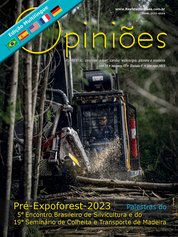Bruno Pimentel Morales
Gerente de Operações Florestais da CMPC
OpCP72
A revolução do uso dos drones nos tratos culturais
Coautores: Matheus Roberto da Silva e Lucas Zancan Pissinin, Coordenadores de Operações Florestais e Bernardo Neutzling Czermainski, Analista Excelência Operacional da CMPC
O setor florestal está bastante aquecido no Brasil e isso se comprova pelos investimentos produtivos industriais e florestais realizados pelas empresas do segmento nos últimos anos. De acordo com a Indústria Brasileira de Árvores – IBÁ, o investimento produtivo total no ano de 2021 foi quase 20% superior ao ano de 2020, somando 15,1 bilhões de reais. Desse montante, os maiores valores foram direcionados para a expansão da capacidade produtiva que, consequentemente, promove um aumento de base florestal.
A evolução do negócio e a expansão de base florestal criam uma grande demanda por recursos e mão de obra, os quais estão cada vez mais limitados no país, tornando-se um desafio a contratação de novos colaboradores e o atendimento das legislações trabalhistas e ambientais.
Para solver esse desafio, é verdadeira a necessidade de avanços no desenvolvimento da mecanização e automatização das atividades silviculturais, que devem estar conectadas a diversos fatores, dentre os quais a inovação e sustentabilidade são pilares indispensáveis.
Diante desse quadro, a incorporação de novas tecnologias, como o uso dos drones, apresenta-se como uma ferramenta estratégica e de fundamental importância.
Ele substitui algumas atividades manuais e mecanizadas, principalmente as aplicações de herbicidas, tornando-se uma alternativa aos cenários de restrições legais, reduzindo a exposição de pessoas a produtos químicos, minimizando riscos de segurança e proporcionando menor consumo de água.
Além disso, torna-se um diferencial na manutenção da prescrição técnica, ou seja, a realização da operação no período e qualidade necessários, sem impactar no acréscimo de custos. Atualmente, existem vários tipos de drones adaptados para a pulverização de herbicidas. No entanto, o correto é que sejam utilizados aqueles que são projetados para tal finalidade e que atendam aos requisitos gerais para o uso de aeronaves não tripuladas detalhados no regulamento brasileiro da aviação civil especial da ANAC.
A regulamentação dos drones ainda é um território bastante complexo, porém as alterações na resolução n° 710 de 31 de Março de 2023 definiram que os RPA’s , durante a aplicação de agroquímicos e adjuvantes sobre áreas desabitadas e até 400 pés, são classificados como classe 3 independentemente do peso máximo de decolagem, desde que operando em VLOS ou EVLOS. Essa revisão evidenciou que as leis estão acompanhando a nova realidade e os avanços das tecnologias; também viabilizou o emprego de drones com tanques de maiores capacidades volumétricas, melhorando a produtividade das operações.
Na CMPC Brasil, os drones são utilizados para a realização de duas atividades principais, capina química pré-plantio com aplicação de herbicidas pré-emergentes e pós-emergentes de forma conjugada e aplicação de pré-emergentes após o plantio. Na execução dessas operações, são observados os conceitos da tecnologia de aplicação e as premissas ambientais vinculadas às condições climáticas adequadas, como a velocidade do vento e a umidade relativa do ar, de forma a garantir que a aplicação esteja bem distribuída, com boa penetração e boa cobertura nos alvos.
Interligado a isso, é importante ressaltar que o emprego de drones, por si só, não alcança os objetivos e brechas da atividade. Temos oportunidades de coevolução em diversos aspectos que podem e devem potencializar o emprego da ferramenta no curto prazo, como o desenvolvimento de produtos que permitem sua aplicação e efetividade com restrições de consumo de água e também produtos com seletividade ao eucalipto e maior espectro de controle das diversas ervas daninhas existentes; além do aprimoramento das pontas de pulverização, permitindo aumento de faixas e cobertura. Podemos evoluir também em baterias com maior capacidade e velocidade de recarga, drones que retornam à base para autoabastecimento e autorrecarga de forma a reduzir o número de pessoas envolvidas na operação. Porém, na medida em que avançamos em todos esses aspectos, não podemos esquecer da formação de pessoas e da mão de obra especializada, elo essencial para concatenar tudo isso.
Outras possibilidades estão associadas à eliminação de brotações de eucalipto e à distribuição de iscas formicidas com drone. A primeira necessita de aprimoramento operacional para garantir a eficácia no controle e a segunda esbarra em restrições de legislação para sua realização.
Em suma, como vimos, inúmeras são as aplicações e potencialidades atuais do uso de drones na silvicultura, uma vez que abre caminhos promissores para uma gestão mais eficiente e sustentável. Não podemos, entretanto, deixar de imaginar e buscar as alternativas para o futuro.
Neste contexto, a utilização de drones para aplicação de agroquímicos na silvicultura, desde atividades pré-plantio, até os tratos culturais, deve ser estruturada dentro de um cenário futuro de silvicultura 100% mecanizada. Devem ser viabilizados sistemas operacionais com telemetria nativa/padronizada desde o preparo de solo, plantio, irrigação e adubação (já presentes no mercado e em estágio avançado de desenvolvimento) com tratos culturais mecanizados ou automatizados, incluindo-se aí os drones.
Outro futuro não muito distante que podemos imaginar e construir em nível operacional é a integração das informações entre diferentes operações mecanizadas através do avanço da IoT, inteligência artificial e outros avanços no processamento de grandes volumes de dados. Porque não podemos gerar um plano de voo para aplicação de herbicida pré-emergente em remonta linha a linha, utilizando-se as informações de georreferenciamento muda a muda já presentes em alguns sistemas de plantios mecanizados? Ou ainda, viabilizarmos operacionalmente nos próprios drones a integração de resultados de mapeamento de cobertura vegetal (NDVI) da vegetação infestante, gerando um plano de voo com aplicação em taxas variáveis, com diferentes volumes de calda em função da infestação geolocalizada nos talhões?
Enfim, o voo para o futuro da silvicultura 100% mecanizada e automatizada está acontecendo à medida em que a tecnologia avança e as regulamentações se ajustam. E os drones na silvicultura farão parte dessa história tornando-se uma ferramenta extremamente valiosa.




